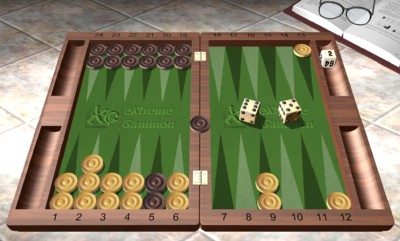These next two positions show a couple of closely related holding game situations. Black has the 20-point, but now he’s got a man stuck on the bar. White has a nice 5-point board, and a couple of blots not in direct range of Black’s anchor. He also has the 9-point, which was an asset for a while, but is now a liability to be cleared. How much risk should he be willing to take while Black is on the bar?
Money game, Black owns the cube, White on roll.

(A) White to play 6-5, 6-3, 5-4, 5-3, 5-2, and 3-2.

(B) Slightly different position, White to play all the same numbers as in (A).
In approaching these technical positions in the later part of the game, I like to use a technique I call “bracketing” (from the old naval gunnery term). Instead of trying to solve one play for one position, I pick a bunch of non-trivial rolls, then make one or two modifications to the position, then solve all the rolls for all the positions, then go back and look for patterns. The patterns will tell you much more about the positions than could any single problem.
So how should White plan to come home? Here we’ve got six rolls for White, and two positions, one where Black has a closed board, and one where Black has a high point open with the possibility of covering it later. Let’s look at the cross-section of plays and problems and see what we can discover about our starting position.
The first big point to notice is the difference between the two Black positions is pretty much an optical illusion. Rollouts showed that moving from (A) to (B) only changes the right play in the case of 6-5, and then only by a tiny margin.
Why wouldn’t a closed board make White play safer? Three reasons:
(1) The closed board doesn’t always hold up. Suppose White’s first roll is 5-2, played 13/6. Of Black’s 11 entering numbers, 5-1 and 5-4 (4 shots) break his board by force. But on 5-2 and 5-3 (4 more shots), Black should break his board voluntarily, rather than moving into the outfield and giving White a double shot, which will win a few extra gammons when he hits. Only 5-5 and 5-6 actually keep Black’s board intact.
(2) Black doesn’t hit very often, so whatever difference there may be doesn’t come into play much.
(3) When Black does hit, the 5-point board is mostly good enough to win anyway.
The second big idea is that if White can clear his 9-point safely, he should do so. Clearing with 6-3 and 5-3 is much better than bringing in a checker. Clearing with 6-5 is tied with making the 7-point, but that’s only because the 7-point makes clearing the 9-point much easier later.
Clearing is such a big deal that’s it’s worth doing with the 3-2 roll (9/6 9/7), despite leaving an indirect shot. (It’s a closer but still correct play if Black has a closed board, because playing 13/10 12/10 makes 5-5 an awful shot for Black.)
If White can’t clear, but he can bring a blot home, then he should bring home the checker on the 13-point; with 5-2 he plays 13/6, and with 5-4 he plays 13/4. He safeties the checker on the 13-point because the checker on the 12-point can get home with more numbers.
Note that with 3-2 White doesn’t have the option of bringing a blot home, so clearing the 9-point becomes best despite the risk.
Solutions:
6-5: (a) 9/3 9/4 (b) 13/7 12/7. Both are very close.
6-3: 9/3 9/6 in both.
5-4: 13/4 in both.
5-3: 9/6 9/4 in both.
5-2: 13/6 in both.
3-2: 9/6 9/7 in both. In (a), 13/10 12/10 is very close.






